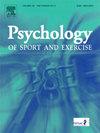乒乓球动作观察中不同特征的神经表征。
IF 3.3
2区 心理学
Q2 HOSPITALITY, LEISURE, SPORT & TOURISM
引用次数: 0
摘要
目的:研究乒乓球发球观察不同特征的神经表征,探讨经验对这些表征的调节作用。方法:24名乒乓球运动员和26名非运动员观看四种乒乓球发球的录像,按发球技术(正手与反手)和目标位置(左与右)进行分类。在视频观看过程中收集功能磁共振成像(fMRI)和行为数据。结果:观察不同的动作特征激活了动作观察网络(AON),包括外侧枕颞皮质(LOTC)、腹侧运动前皮质(PMv)和顶叶上小叶(SPL)。多变量模式分析揭示了AON内不同区域的不同功能贡献:乒乓球运动员对动作类型的PMv解码准确率高于动作目标,而SPL对动作目标的解码准确率高于动作类型。值得注意的是,与非运动员相比,运动员对动作类型的PMv解码准确率明显更高。结论:这些发现强调了AON子区域在不同动作观察特征中的不同参与,并强调了经验在形成所观察动作的神经表征中的关键作用。本研究为优化运动训练与技能习得提供理论见解。本文章由计算机程序翻译,如有差异,请以英文原文为准。
Neural representations of different features in the observation of table tennis actions
Objective
This study investigated the neural representations at different features of table tennis serve observation and examined the moderating effects of experience on these representations.
Methods
Twenty-four table tennis athletes and twenty-six nonathletes watched videos of four types of table tennis serves, categorized by serve technique (forehand vs. backhand) and target location (left-side vs. right-side). Functional magnetic resonance imaging (fMRI) and behavioral data were collected during video viewing.
Results
Observing different action features activated the action observation network (AON), including the lateral occipital-temporal cortex (LOTC), ventral premotor cortex (PMv), and superior parietal lobule (SPL). Multivariate pattern analysis revealed the distinct functional contributions of different regions within the AON: table tennis players exhibited higher decoding accuracy in the PMv for action types than for action targets, whereas the SPL showed greater decoding accuracy for action targets over action types. Notably, players demonstrated significantly higher PMv decoding accuracy for action types compared to nonathletes.
Conclusions
These findings highlight the differential involvement of AON subregions of different features of action observation and emphasize the crucial role of experience in shaping neural representations of observed actions. This study provides theoretical insights for optimizing sports training and skill acquisition.
求助全文
通过发布文献求助,成功后即可免费获取论文全文。
去求助
来源期刊
CiteScore
6.40
自引率
5.90%
发文量
172
审稿时长
69 days
期刊介绍:
Psychology of Sport and Exercise is an international forum for scholarly reports in the psychology of sport and exercise, broadly defined. The journal is open to the use of diverse methodological approaches. Manuscripts that will be considered for publication will present results from high quality empirical research, systematic reviews, meta-analyses, commentaries concerning already published PSE papers or topics of general interest for PSE readers, protocol papers for trials, and reports of professional practice (which will need to demonstrate academic rigour and go beyond mere description). The CONSORT guidelines consort-statement need to be followed for protocol papers for trials; authors should present a flow diagramme and attach with their cover letter the CONSORT checklist. For meta-analysis, the PRISMA prisma-statement guidelines should be followed; authors should present a flow diagramme and attach with their cover letter the PRISMA checklist. For systematic reviews it is recommended that the PRISMA guidelines are followed, although it is not compulsory. Authors interested in submitting replications of published studies need to contact the Editors-in-Chief before they start their replication. We are not interested in manuscripts that aim to test the psychometric properties of an existing scale from English to another language, unless new validation methods are used which address previously unanswered research questions.

 求助内容:
求助内容: 应助结果提醒方式:
应助结果提醒方式:


